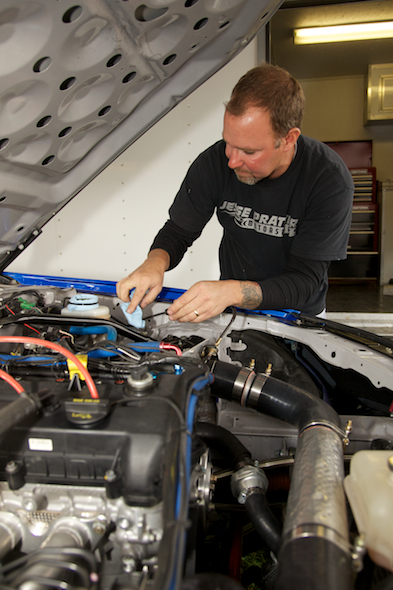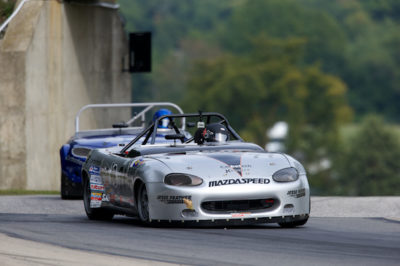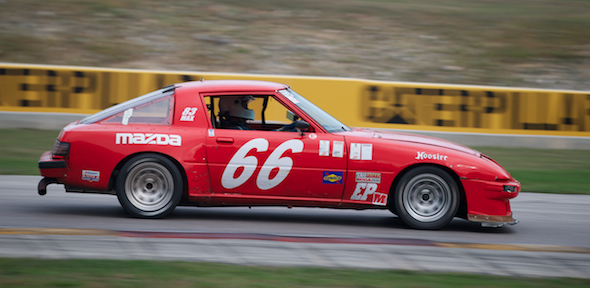There’s no doubt racing is fun and challenging at any level. But sometimes you just want to go faster. In many forms of racing, there are numerous things you can do to go faster, most of which cost money. Maybe a lot of money. If you’re racing a class like Spec Miata, though, there’s not a whole lot you can do to go faster, even if you have the funds.
Then it’s time to move up a class. For someone in Spec Miata, the logical destination might be one of the SCCA Production classes where Miatas and MX-5s compete: E and F Production. The Production classes are based on road-going cars, but the rules provide enough latitude that they can go faster – much faster. It starts with the fact that the class runs on slicks. But the suspension allowances and certainly the engine allowances are such that there is a lot more speed that can be wrung out of any given car. Plus the cars lose a lot of weight and become much stiffer in the build process.
Jesse Prather builds championship-winning Production cars. He’s built numerous Miatas and races an E Production MX-5 himself. He says that while the speeds are higher in the Production category, those contemplating a move shouldn’t be intimidated.

“I get a lot of [Improved Touring] and Spec Miata guys that are coming into Production,” he says. “If you can drive a Spec Miata well, you can pretty much drive any racecar, because driving a Spec Miata or IT Miata teaches you to drive and how to keep up your momentum. The beauty of getting into a Production car is now we’ve got a car that makes more horsepower, goes faster down the straights, handles better. So it’s a lot more car. It takes some guys more time to transition into the speed. But they’re a lot of fun to drive.”
It may be tempting for someone who already has an IT Miata (or RX-7) or a Spec Miata to think about turning it into a Production car. But Prather advises against it. While both are built from road-going cars, they are rather different beasts.
“Because of what’s in the Spec Miata, it’s better to sell the car and start with a fresh donor,” he explains. “If we’re going to convert a Spec Miata, we have to essentially remove the entire rollcage and put in a rollcage with a lot more pickup points. We’re already pulling the suspension apart, we’re already pulling the motor and transmission out. If we’re going to do all that, we might as well start with a street car.
“Your Spec Miata has value, so sell the Spec Miata and build another car. You can build another car while you race the Spec Miata, and you can transition very easily.”
Building a Production car is generally considerably more expensive than building a Spec Miata, donor car aside. Once the car is built, though, running costs are not going to be exponentially higher; but some increase in one’s annual racing budget should be expected.
“In Production, because we’re allowed to do so much more to the car, you’re going to consume more,” Prather says. “You’re going to consume more brakes; your engine is not going to last as long between rebuilds. But once the car is built, I wouldn’t say the cost to run the car is a lot more. It costs more to build the car because we’re doing so much more to the car.”



 ACCESSIBILITY
ACCESSIBILITY